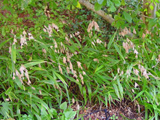Native Plants

Q. Who is Mr. Smarty Plants?
A: There are those who suspect Wildflower Center volunteers are the culpable and capable culprits. Yet, others think staff members play some, albeit small, role. You can torture us with your plant questions, but we will never reveal the Green Guru's secret identity.
Did you know you can access the Native Plant Information Network with your web-enabled smartphone?
Ask Mr. Smarty Plants is a free service provided by the staff and volunteers at the Lady Bird Johnson Wildflower Center.

rate this answer
Saturday - January 05, 2008
From: San Antonio, TX
Region: Southwest
Topic: Grasses or Grass-like
Title: Post freeze care for Texas native grasses
Answered by: Barbara Medford
QUESTION:
Can you tell me the best post-freeze care for Tx native grasses in my garden: lindheimer muhly, gulf muhly, inland sea oats. Mexican feather grass. Do I cut them back? Burn them? Leave them alone? Thank you.ANSWER:
The key word in your question is "native." When you select plants that are already adapted to an area, it cuts down on the maintenance that has to be done. Muhlenbergia lindheimeri (Lindheimer's muhly), Muhlenbergia capillaris (hairawn muhly), Chasmanthium latifolium (Inland sea oats), and Nassella tenuissima (finestem needlegrass) are all native to this area, and will suffer little, if any, from frost. With all grasses, the main concern in trimming is keeping them tidy. It's probably best to leave any dead stems on the grasses until the chances of frost are well over, as the overhanging grasses will help to protect the green part of the plant from an excessive freeze. Then, you might cut about 1/3 of the plant back, and thoroughly rake out any dead or cut ends. Keeping the dead grasses out of the plants is important both to appearance and because the dry material can be a burn hazard. Obviously, we do not advise that you burn anything, especially now with the dry weather in Central Texas, along with high winds.
More Grasses or Grass-like Questions
Plants for a moist, shady spot in central Texas
July 08, 2016 - I am looking for a plant that will grow in almost full shade with plenty of moisture along a fence. We are looking at putting down some flagstone with possibly some moss growing in between, but we don...
view the full question and answer
Evergreen grasslike plants for Austin TX
April 15, 2008 - Hi,
I'm in Austin, TX and looking for some evergreen grass-looking plants. Would you explain the similarities/differences between Butterfly Iris and Lily Grass in this regard? Thank you
view the full question and answer
Evergreen ground cover for San Antonio
August 03, 2011 - Is there a short, evergreen, drought tolerant ground cover which will tolerate light traffic that can be used instead of grass? San Antonio, Texas
view the full question and answer
Removing bermudagrass from buffalograss in Smithville TX
May 01, 2013 - I have a lawn created two years ago with buffalo grass sod in Smithville, TX. Recently several areas of bermudagrass have started to flourish in the buffalo grass lawn. Can you recommend a herbicide...
view the full question and answer
Difference between Pseudoroegneria spicata and Elymus trachycaulus
May 21, 2007 - What is the difference between Pseudoroegneria spicata and Elymus trachycaulus.
view the full question and answer
| Support the Wildflower Center by Donating Online or Becoming a Member today. |

